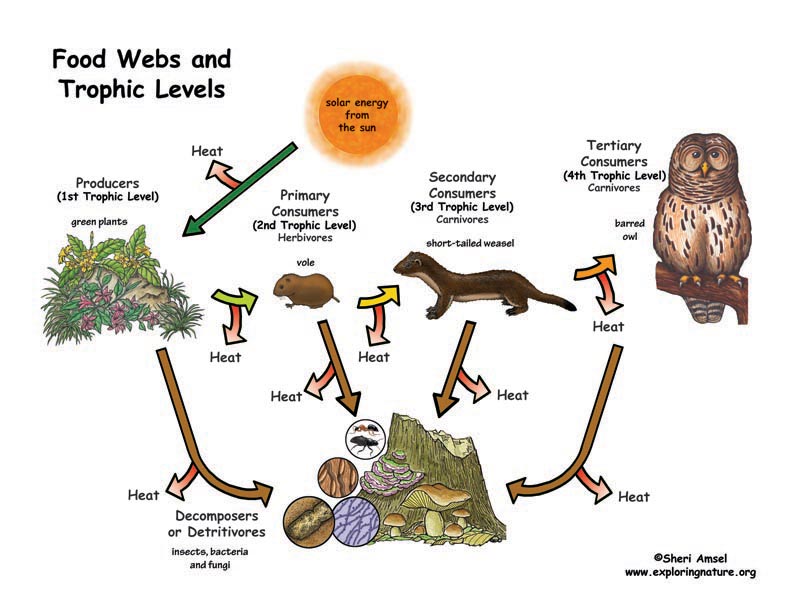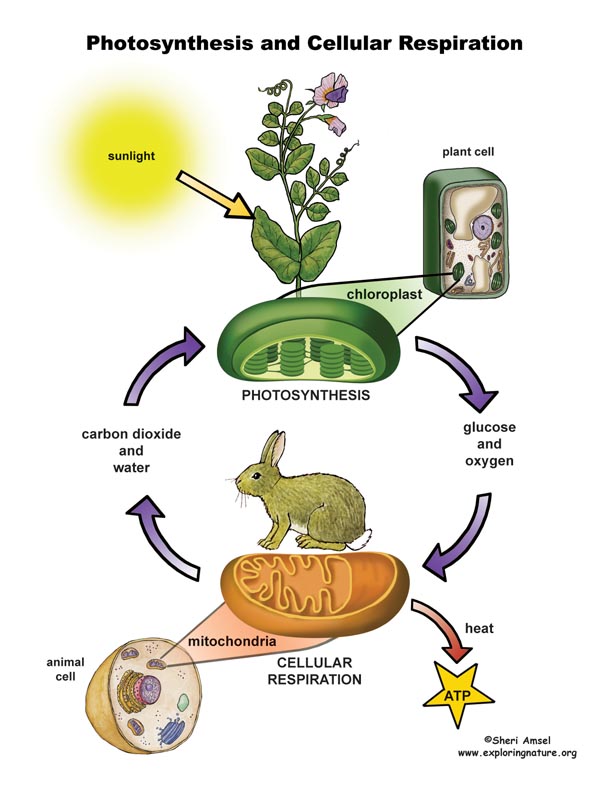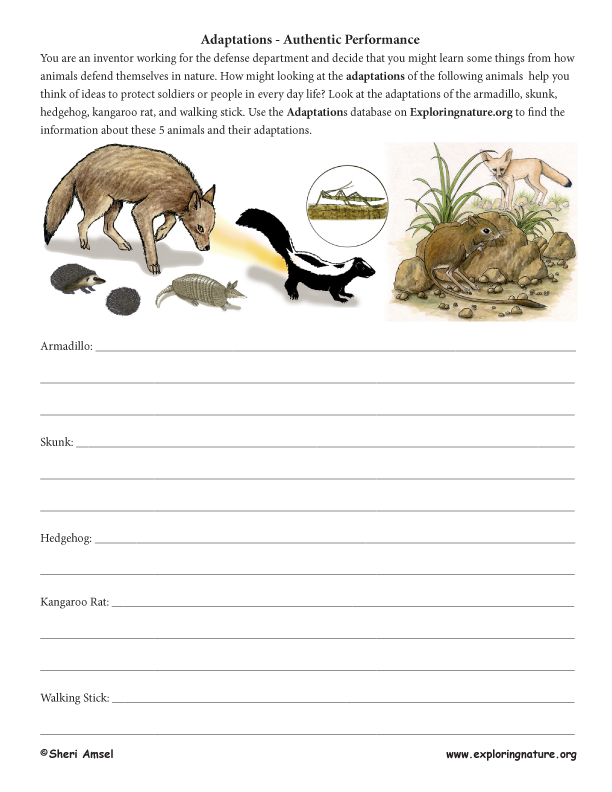

_________________________________________________________________________________________________________________________________________________________
Disciplinary Core Ideas
LS2.A: Interdependent Relationships in Ecosystems
• Ecosystems have carrying capacities, which are limits to the numbers of organisms and populations they can support. These limits result from such factors as the availability of living and nonliving resources and from such challenges such as predation, competition, and disease. Organisms would have the capacity to produce populations of great size were it not for the fact that environments and resources are finite. This fundamental tension affects the abundance (number of individuals) of species in any given ecosystem. (HS-LS2-1),(HS-LS2-2)
LS2.B: Cycle of Matter and Energy Transfer in Ecosystems
• Photosynthesis and cellular respiration (including anaerobic processes) provide most of the energy for life processes. (HS-LS2-3)
• Plants or algae form the lowest level of the food web. At each link upward in a food web, only a small fraction of the matter consumed at the lower level is transferred upward, to produce growth and release energy in cellular respiration at the higher level. Given this inefficiency, there are generally fewer organisms at higher levels of a food web. Some matter reacts to release energy for life functions, some matter is stored in newly made structures, and much is discarded. The chemical elements that make up the molecules of organisms pass through food webs and into and out of the atmosphere and soil, and they are combined and recombined in different ways. At each link in an ecosystem, matter and energy are conserved. (HS-LS2-4)
• Photosynthesis and cellular respiration are important components of the carbon cycle, in which carbon is exchanged among the biosphere, atmosphere, oceans, and geosphere through chemical, physical, geological, and biological processes. (HS-LS2-5)
LS2.C: Ecosystem Dynamics, Functioning, and Resilience
• A complex set of interactions within an ecosystem can keep its numbers and types of organisms relatively constant over long periods of time under stable conditions. If a modest biological or physical disturbance to an ecosystem occurs, it may return to its more or less original status (i.e., the ecosystem is resilient), as opposed to becoming a very different ecosystem. Extreme fluctuations in conditions or the size of any population, however, can challenge the functioning of ecosystems in terms of resources and habitat availability. (HS-LS2-2),(HS-LS2-6)
• Moreover, anthropogenic changes (induced by human activity) in the environment—including habitat destruction, pollution, introduction of invasive species, overexploitation, and climate change—can disrupt an ecosystem and threaten the survival of some species. (HS-LS2-7)
LS2.D: Social Interactions and Group Behavior
• Group behavior has evolved because membership can increase the chances of survival for individuals and their genetic relatives. (HS-LS2-8)
LS4.D: Biodiversity and Humans
• Biodiversity is increased by the formation of new species (speciation) and decreased by the loss of species (extinction). (secondary to HS-LS2-7)
• Humans depend on the living world for the resources and other benefits provided by biodiversity. But human activity is also having adverse impacts on biodiversity through overpopulation, overexploitation, habitat destruction, pollution, introduction of invasive species, and climate change. Thus sustaining biodiversity so that ecosystem functioning and productivity are maintained is essential to supporting and enhancing life on Earth. Sustaining biodiversity also aids humanity by preserving landscapes of recreational or inspirational value. (secondary to HS-LS2-7) (Note: This Disciplinary Core Idea is also addressed by HS-LS4-6.)
PS3.D: Energy in Chemical Processes
• There are systematic processes for evaluating solutions with respect to how well they meet the criteria and constraints of a problem. (secondary to MS-LS2-5)
ETS1.B: Developing Possible Solutions
• When evaluating solutions it is important to take into account a range of constraints including cost, safety, reliability and aesthetics and to consider social, cultural and environmental impacts. (secondary to HS-LS2-7)
_________________________________________________________________________________________________________________________________________________________
Use the Template and Resource Links to Fulfill NGSS
l. Goals:
Essential Questions:
NGSS Note: Think, question, entertain ideas.
ll. Introductory Activities to Assess Prior Knowledge
A. Answer Questions - that assess students’ understanding of photosynthesis and cellular respiration.
Quizes:
Photosynthesis - Multiple Choice Test
Cellular Respiration Multiple Choice Quiz
Photosynthesis and Cellular Respiration Labeling
B. Explain this - to demonstrate your understanding of the topic.
Photosynthesis - Comic Comprehension
Explain how destruction of more than half of the Everglades affected the area.
Explain how animals living in groups might improve their chances for survival.
lll. New Knowledge - Text
A. Read about foodwebs:
Food Webs - The Nutrient Cycle
About Food Webs and Trophic Levels
Read about adaptation:
Read about photosynthesis and cellular respiration:
Photosynthesis
Photosynthesis and Cellular Respiration
Read about environmental issues:
B. Examples of Models (depicts the concept expressed in the reading):
Ask students to look at the models and explain how each illustrates the concepts they've read about.
A. Inquiry related to above topics:
Study the how photosynthesis works:
B. Authentic Performance - Understanding by Design (UbD) assessment tool.
Use critical thinking to complete thse Authentic Performance Activities and deepen your understanding about the above topics.
V. Summarize Knowledge - Enduring Understandings
Vl. New Generation of Science Standards (NGSS) - High School Life Science
Disciplinary Core Ideas
LS2.A: Interdependent Relationships in Ecosystems
• Ecosystems have carrying capacities, which are limits to the numbers of organisms and populations they can support. These limits result from such factors as the availability of living and nonliving resources and from such challenges such as predation, competition, and disease. Organisms would have the capacity to produce populations of great size were it not for the fact that environments and resources are finite. This fundamental tension affects the abundance (number of individuals) of species in any given ecosystem. (HS-LS2-1),(HS-LS2-2)
LS2.B: Cycle of Matter and Energy Transfer in Ecosystems
• Photosynthesis and cellular respiration (including anaerobic processes) provide most of the energy for life processes. (HS-LS2-3)
• Plants or algae form the lowest level of the food web. At each link upward in a food web, only a small fraction of the matter consumed at the lower level is transferred upward, to produce growth and release energy in cellular respiration at the higher level. Given this inefficiency, there are generally fewer organisms at higher levels of a food web. Some matter reacts to release energy for life functions, some matter is stored in newly made structures, and much is discarded. The chemical elements that make up the molecules of organisms pass through food webs and into and out of the atmosphere and soil, and they are combined and recombined in different ways. At each link in an ecosystem, matter and energy are conserved. (HS-LS2-4)
• Photosynthesis and cellular respiration are important components of the carbon cycle, in which carbon is exchanged among the biosphere, atmosphere, oceans, and geosphere through chemical, physical, geological, and biological processes. (HS-LS2-5)
LS2.C: Ecosystem Dynamics, Functioning, and Resilience
• A complex set of interactions within an ecosystem can keep its numbers and types of organisms relatively constant over long periods of time under stable conditions. If a modest biological or physical disturbance to an ecosystem occurs, it may return to its more or less original status (i.e., the ecosystem is resilient), as opposed to becoming a very different ecosystem. Extreme fluctuations in conditions or the size of any population, however, can challenge the functioning of ecosystems in terms of resources and habitat availability. (HS-LS2-2),(HS-LS2-6)
• Moreover, anthropogenic changes (induced by human activity) in the environment—including habitat destruction, pollution, introduction of invasive species, overexploitation, and climate change—can disrupt an ecosystem and threaten the survival of some species. (HS-LS2-7)
LS2.D: Social Interactions and Group Behavior
• Group behavior has evolved because membership can increase the chances of survival for individuals and their genetic relatives. (HS-LS2-8)
LS4.D: Biodiversity and Humans
• Biodiversity is increased by the formation of new species (speciation) and decreased by the loss of species (extinction). (secondary to HS-LS2-7)
• Humans depend on the living world for the resources and other benefits provided by biodiversity. But human activity is also having adverse impacts on biodiversity through overpopulation, overexploitation, habitat destruction, pollution, introduction of invasive species, and climate change. Thus sustaining biodiversity so that ecosystem functioning and productivity are maintained is essential to supporting and enhancing life on Earth. Sustaining biodiversity also aids humanity by preserving landscapes of recreational or inspirational value. (secondary to HS-LS2-7) (Note: This Disciplinary Core Idea is also addressed by HS-LS4-6.)
PS3.D: Energy in Chemical Processes
• There are systematic processes for evaluating solutions with respect to how well they meet the criteria and constraints of a problem. (secondary to MS-LS2-5)
ETS1.B: Developing Possible Solutions
• When evaluating solutions it is important to take into account a range of constraints including cost, safety, reliability and aesthetics and to consider social, cultural and environmental impacts. (secondary to HS-LS2-7)
Science and Engineering Practices (NGSS)
Developing and Using Models
Modeling in 9–12 builds on K–8 experiences and progresses to using, synthesizing, and developing models to predict and show how relationships among variables between systems and their components in the natural and designed worlds.
• Develop a model based on evidence to illustrate the relationships between systems or components of a system. (HS-LS2-5)
Using Mathematics and Computational Thinking
Mathematical and computational thinking in 9-12 builds on K-8 experiences and progresses to using algebraic thinking and analysis, a range of linear and nonlinear functions including trigonometric functions, exponentials and logarithms, and computational tools for statistical analysis to analyze, represent, and model data. Simple computational simulations are created and used based on mathematical models of basic assumptions.
• Use mathematical and/or computational representations of phenomena or design solutions to support explanations. (HS-LS2-1)
• Use mathematical representations of phenomena or design solutions to support and revise explanations. (HS-LS2-2)
• Use mathematical representations of phenomena or design solutions to support claims. (HS-LS2-4)
Constructing Explanations and Designing Solutions
Constructing explanations and designing solutions in 9–12 builds on K–8 experiences and progresses to explanations and designs that are supported by multiple and independent student-generated sources of evidence consistent with scientific ideas, principles, and theories.
• Construct and revise an explanation based on valid and reliable evidence obtained from a variety of sources (including students’ own investigations, models, theories, simulations, peer review) and the assumption that theories and laws that describe the natural world operate today as they did in the past and will continue to do so in the future. (HS-LS2-3)
• Design, evaluate, and refine a solution to a complex real-world problem, based on scientific knowledge, student-generated sources of evidence, prioritized criteria, and tradeoff considerations. (HS-LS2-7)
Engaging in Argument from Evidence
Engaging in argument from evidence in 9–12 builds on K–8 experiences and progresses to using appropriate and sufficient evidence and scientific reasoning to defend and critique claims and explanations about the natural and designed world(s). Arguments may also come from current scientific or historical episodes in science.
• Evaluate the claims, evidence, and reasoning behind currently accepted explanations or solutions to determine the merits of arguments. (HS-LS2-6)
• Evaluate the evidence behind currently accepted explanations to determine the merits of arguments. (HS-LS2-8)
Connections of Nature and Science
Scientific Knowledge is Open to Revision in Light of New Evidence
• Most scientific knowledge is quite durable, but is, in principle, subject to change based on new evidence and/or reinterpretation of existing evidence. (HS-LS2-2),(HS-LS2-3)
• Scientific argumentation is a mode of logical discourse used to clarify the strength of relationships between ideas and evidence that may result in revision of an explanation. (HS-LS2-6),(HS-LS2-8)
Crosscutting Concepts (NGSS)
Cause and Effect
• Empirical evidence is required to differentiate between cause and correlation and make claims about specific causes and effects. (HS-LS2-8)
Scale, Proportion, and Quantity
• The significance of a phenomenon is dependent on the scale, proportion, and quantity at which it occurs. (HS-LS2-1)
• Using the concept of orders of magnitude allows one to understand how a model at one scale relates to a model at another scale. (HS-LS2-2)
Systems and System Models
• Models (e.g., physical, mathematical, computer models) can be used to simulate systems and interactions—including energy, matter, and information flows—within and between systems at different scales. (HS-LS2-5)
Energy and Matter
• Energy cannot be created or destroyed—it only moves between one place and another place, between objects and/or fields, or between systems. (HS-LS2-4)
• Energy drives the cycling of matter within and between systems. (HS-LS2-3)
Stability and Change
• Much of science deals with constructing explanations of how things change and how they remain stable. (HS-LS2-6),(HS-LS2-7)
Performance Expectations
Students who demonstrate understanding can:
HS-LS2-1. Use mathematical and/or computational representations to support explanations of factors that affect carrying capacity of ecosystems at different scales. [Clarification Statement: Emphasis is on quantitative analysis and comparison of the relationships among interdependent factors including boundaries, resources, climate, and competition. Examples of mathematical comparisons could include graphs, charts, histograms, and population changes gathered from simulations or historical data sets.] [Assessment Boundary: Assessment does not include deriving mathematical equations to make comparisons.]
HS-LS2-2. Use mathematical representations to support and revise explanations based on evidence about factors affecting biodiversity and populations in ecosystems of different scales. [Clarification Statement: Examples of mathematical representations include finding the average, determining trends, and using graphical comparisons of multiple sets of data.] [Assessment Boundary: Assessment is limited to provided data.]
HS-LS2-3. Construct and revise an explanation based on evidence for the cycling of matter and flow of energy in aerobic and anaerobic conditions. [Clarification Statement: Emphasis is on conceptual understanding of the role of aerobic and anaerobic respiration in different environments.] [Assessment Boundary: Assessment does not include the specific chemical processes of either aerobic or anaerobic respiration.]
HS-LS2-4. Use mathematical representations to support claims for the cycling of matter and flow of energy among organisms in an ecosystem. [Clarification Statement: Emphasis is on using a mathematical model of stored energy in biomass to describe the transfer of energy from one trophic level to another and that matter and energy are conserved as matter cycles and energy flows through ecosystems. Emphasis is on atoms and molecules such as carbon, oxygen, hydrogen and nitrogen being conserved as they move through an ecosystem.] [Assessment Boundary: Assessment is limited to proportional reasoning to describe the cycling of matter and flow of energy.]
HS-LS2-5. Develop a model to illustrate the role of photosynthesis and cellular respiration in the cycling of carbon among the biosphere, atmosphere, hydrosphere, and geosphere. [Clarification Statement: Examples of models could include simulations and mathematical models.] [Assessment Boundary: Assessment does not include the specific chemical steps of photosynthesis and respiration.]
HS-LS2-6. Evaluate the claims, evidence, and reasoning that the complex interactions in ecosystems maintain relatively consistent numbers and types of organisms in stable conditions, but changing conditions may result in a new ecosystem. [Clarification Statement: Examples of changes in ecosystem conditions could include modest biological or physical changes, such as moderate hunting or a seasonal flood; and extreme changes, such as volcanic eruption or sea level rise.]
HS-LS2-7. Design, evaluate, and refine a solution for reducing the impacts of human activities on the environment and biodiversity.* [Clarification Statement: Examples of human activities can include urbanization, building dams, and dissemination of invasive species.]
HS-LS2-8. Evaluate the evidence for the role of group behavior on individual and species’ chances to survive and reproduce. [Clarification Statement: Emphasis is on: (1) distinguishing between group and individual behavior, (2) identifying evidence supporting the outcomes of group behavior, and (3) developing logical and reasonable arguments based on evidence. Examples of group behaviors could include flocking, schooling, herding, and cooperative behaviors such as hunting, migrating, and swarming.]
Common Core State Standards Connections
ELA/Literacy
RST.9-10.8 Assess the extent to which the reasoning and evidence in a text support the author’s claim or a recommendation for solving a scientific or technical problem. (HS-LS2-6),(HS-LS2-7),(HS-LS2-8)
RST.11-12.1 Cite specific textual evidence to support analysis of science and technical texts, attending to important distinctions the author makes and to any gaps or inconsistencies in the account. (HS-LS2-1),(HS-LS2-2),(HS-LS2-3),(HS-LS2-6),(HS-LS2-8)
RST.11-12.7 Integrate and evaluate multiple sources of information presented in diverse formats and media (e.g., quantitative data, video, multimedia) in order to address a question or solve a problem. (HS-LS2-6),(HS-LS2-7),(HS-LS2-8)
RST.11-12.8 Evaluate the hypotheses, data, analysis, and conclusions in a science or technical text, verifying the data when possible and corroborating or challenging conclusions with other sources of information. (HS-LS2-6),(HS-LS2-7),(HS-LS2-8)
WHST.9-12.2 Write informative/explanatory texts, including the narration of historical events, scientific procedures/ experiments, or technical processes. (HS-LS2-1),(HS-LS2-2),(HS-LS2-3)
WHST.9-12.5 Develop and strengthen writing as needed by planning, revising, editing, rewriting, or trying a new approach, focusing on addressing what is most significant for a specific purpose and audience. (HS-LS2-3)
WHST.9-12.7 Conduct short as well as more sustained research projects to answer a question (including a self-generated question) or solve a problem; narrow or broaden the inquiry when appropriate; synthesize multiple sources on the subject, demonstrating understanding of the subject under investigation. (HS-LS2-7)
Mathematics
MP.2 Reason abstractly and quantitatively. (HS-LS2-1),(HS-LS2-2),(HS-LS2-4),(HS-LS2-6),(HS-LS2-7)
MP.4 Model with mathematics. (HS-LS2-1),(HS-LS2-2),(HS-LS2-4)
HSN.Q.A.1 Use units as a way to understand problems and to guide the solution of multi-step problems; choose and interpret units consistently in formulas; choose and interpret the scale and the origin in graphs and data displays. (HS-LS2-1),(HS-LS2-2),(HS-LS2-4),(HS-LS2-7)
HSN.Q.A.2 Define appropriate quantities for the purpose of descriptive modeling. (HS-LS2-1),(HS-LS2-2),(HS-LS2-4),(HS-LS2-7)
HSN.Q.A.3 Choose a level of accuracy appropriate to limitations on measurement when reporting quantities. (HS-LS2-1),(HS-LS2-2),(HS-LS2-4),(HS-LS2-7)
HSS-ID.A.1 Represent data with plots on the real number line. (HS-LS2-6)
HSS-IC.A.1 Understand statistics as a process for making inferences about population parameters based on a random sample from that population. (HS-LS2-6)
HSS-IC.B.6 Evaluate reports based on data. (HS-LS2-6)
When you research information you must cite the reference. Citing for websites is different from citing from books, magazines and periodicals. The style of citing shown here is from the MLA Style Citations (Modern Language Association).
When citing a WEBSITE the general format is as follows.
Author Last Name, First Name(s). "Title: Subtitle of Part of Web Page, if appropriate." Title: Subtitle: Section of Page if appropriate. Sponsoring/Publishing Agency, If Given. Additional significant descriptive information. Date of Electronic Publication or other Date, such as Last Updated. Day Month Year of access < URL >.
Amsel, Sheri. "Grade 9-12 - HS-LS2 Ecosystems: Interactions, Energy, and Dynamics" Exploring Nature Educational Resource ©2005-2024. December 13, 2024
< http://www.exploringnature.org/db/view/Grade-9-12-HS-LS2-Ecosystems-Interactions-Energy-and-Dynamics >








